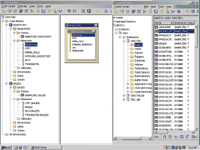Qliktech, IBM Provide New View Of OLAP
QlikTech's QlikView, which represents the next generation of business intelligence and OLAP architecture, can construct data structures on the fly in nonrelational associative databases.

\
MARIO MOREJON
\
Technical Editor
On the surface, QlikView is a complete business intelligence solution that consists of a data source integration module, analytics engine and user interface. QlikView is based on a patented architecture called Associative Query Logic (AQL) and is completely different from other OLAP tools.
Through AQL, QlikView eliminates the need for data cubes and data warehousing, replacing the cube structure with a patented data structure called a Data Cloud. The Data Cloud does not contain any pre-aggregated data but instead builds nonredundant tables and keeps them in memory at all times. Queries are then created on the fly and are run against the Data Cloud's in-memory data store.
Under AQL, all data is stored only once, and all data associations are stored as pointers, so a Data Cloud database becomes more efficient at retrieving records than do OLAP databases. A Data Cloud database is also much smaller since records are not repeated through aggregation and its structure never has to change. The architecture allows for a flexible end-user experience because it doesn't require aggregation or precanned queries that try to cover every possible analytical scenario a user can create.
In a typical OLAP architecture, business analysts are always trying to anticipate what end users want before data structures are created. Since the result that is compiled by users can be quite complex, the up-front development required to create the plumbing is slow and must be repeated until all possibilities have been exhausted. This usually happens at the request of the end user.

\
IBM DB2 CUBE VIEWS
\
Test Center Recommended
With AQL, field associations can be created in innovative ways. When testing the product, for example, CRN Test Center engineers were impressed by how easily the front-end data views were created without having to change any back-end structures. Engineers were able to discover associations between unrelated fields by using normal relational integrity among tables.
But there have been major innovations made in OLAP technology as well.
For example, IBM's Cube Views, a DB2 add-on aimed at speeding up development, creates specialized relational structures within DB2 and exposes its data to business intelligence vendors.
IBM has said that it no longer wants to compete with business intelligence vendors and instead wants to offer a back-end infrastructure. Cube Views makes its metadata available by allowing it to be bridged via data connectors to any business intelligence software in the market. This architecture improves the performance of business intelligence tools because its data structures are already created inside DB2, so the database does all the preliminary work necessary to create a cube. Cube Views creates metadata within DB2 for OLAP, but it's neither a metadata management system nor an OLAP tool.
Cube Views uses Materialized Query Tables (MQT), which are summary tables of multiple fields from two or more tables in a data warehouse. MQTs are created at design time by Cube Views and are stored in DB2. At runtime MQTs are accessed directly by business intelligence tools. In essence, these are aggregate tables built on relations among base tables. MQTs are often utilized by DB2 because their data is already formed to match aggregate queries and therefore are more efficient.
For instance, instead of using base tables every time a query is executed, DB2 will analyze the query and link it to an alternative summary table if it exists. It then uses a system catalog to route SQL from the base table to the summary table dynamically.
CHANNEL PROGRAM SNAPSHOTS
>IBM DB2CUBE VIEWS (Test Center Recommended)
PRICE: $7,500 per CPU
MDFs: Yes
DISTRIBUTORS: Ingram Micro, Avnet Hall-mark
TECH RATING:

CHANNEL RATING:

CHANNEL OVERVIEW: Various levels of training, sales and technical support and demand-generation assistance are available from IBM's three-tiered PartnerWorld channel program. IBM, Armonk, N.Y., provides application design assistance, along with sales and marketing tools and technical information via its partner Web site. Sales and technical training are available online, on-site or in traveling labs under IBM's "You Pass, We Pay" program. --Michael Gros
>QLIKTECH QLIKVIEW 6
PRICE: $2,995
MDFs: Yes
WARRANTY: 90 days
DISTRIBUTORS: Direct from vendor
TECH RATING:

CHANNEL RATING:

CHANNEL OVERVIEW: Raleigh, N.C.-based QlikTech adjusts its pricing and support based on partner type and particular circumstances. The vendor's direct-sales reps provide sales assistance, and its engineers do joint sales calls and assist with installations. QlikTech provides customized, on-site sales and technical training. --Michael Gros
Note: Vendors can earn up to five stars for technical merit and five for their channel program. If the average of these two scores is four stars or greater, the product earns CRN Test Center Recommended status.